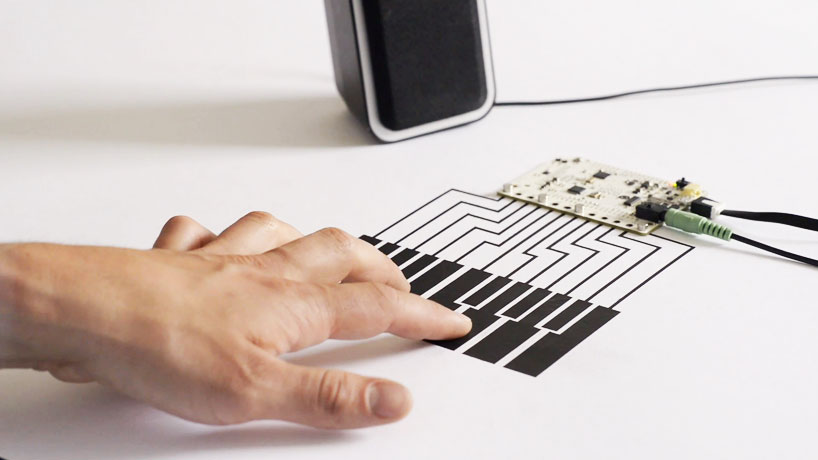About Conductive paint:

Conductive paint
Bare Conductive’s Electric Paint is just like any other water-based paint… except that it’s electrically conductive! This means that you can actually paint wires onto things like models, clothes, furniture, walls, almost anything you can think of. Standard acrylic or water-based paints can even be used alongside Electric Paint to act as insulation or to create multi-layer circuitry!
You can apply Bare’s Electric Paint like any other water-based paint. You can use a brush, a roller, printmaking equipment, some intrepid users have even tried to spray the material through an airbrush! It’s important to note that as Electric Paint dries the conductivity increases (and will continue to increase to a certain extent even after the paint “feels” dry), so if your project requires calibration, let the paint dry completely before testing it.
Note: Electric Paint is not meant for use on skin!
Note: Electric Paint is not waterproof, but depending on what your application is you can paint over it with a waterproof paint or varnish. On the bright side, this does make for easy cleanup.

Conductive paint tattoo
Features:
- Water-based, nontoxic and dries at room temperature.
- Electric Paint can be applied to a wide variety of materials, including (but certainly not limited to) paper, cardboard vellum, wood, metal, plaster, some rubbers, plastics and many textiles.
- Soap and warm water will take Electric Paint off of most surfaces.
- Can last years if treated properly and kept dry.
- Great way for cost saving.
History: A group of students from the Royal College of Art (RCA) in London has made that possible by creating electrically conductive paint.
The team began by investigating how electronics were being used in the body.
“In 2008 — and probably still today — there was a lot of work around electronic textiles,” says Johnson. “And though we really liked the idea of having a jumper (a piece of clothing) that has some intelligence in it, we didn’t like that it was so bulky and that once you took it off the functionality disappeared.”
Around the same time, there was a lot of “extreme work” being done by people who were injecting electronics beneath the skin. For their final project, the RCA students began work on making something less intrusive, looking for a substance that could be painted onto the body. Eventually, says Johnson, “that idea transformed into the material we have now, which is very safe though it’s not specifically intended for the body anymore.”
Read: Designs that will define our future
After graduating from college, the team collaborated on a video for DJ and producer Calvin Harris. The resulting project was the “Humanthesizer,” a performance which literally brought the paint to life, with dancers whose movements triggered audio loops from Harris’s song “Ready for the Weekend.”
Matt Johnson, co-inventor, Bare Conductive
“Making a new material was a bit daunting for four designers,” says Johnson. The team’s solution was not to return to school to study chemistry for four years. Instead, they simply went on Wikipedia. According to Johnson, the online encyclopedia provided them with almost everything they needed to know about crafting conductive materials.
Once the paint’s formula was finalized, co-creator Isabel Lizardi says the team began to consider how it might be applied to real-world products. The first thing they launched was the paint in its raw form, which they made available to other garden-shed inventors.
Today, Bare Paint jars and pens are sold on the Internet and stocked by Radio Shack electronics stores across the United States. Projects being done by Bare Paint users include everything from interactive color wheels to homemade electric toys.
Johnson says that conductive paint opens up an enormous range of creative opportunities. As conductive paint becomes increasingly common, we can look forward to a future where billboards talk back, walls are interactive, and greeting cards come to life in our very hands.
“Devices no longer have to look high tech to be high tech,” Johnson says. “Our goal is to put interactivity onto objects you don’t expect.”
Also see: Google Lens: New application from Google in 2017
http://ftvweb.com/2017/06/13/google-lens-new-application-from-google/

Google lens
